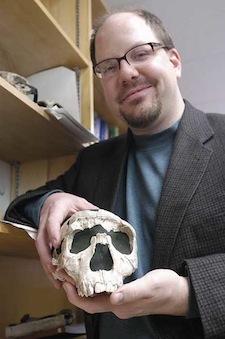‘Human Evolution: Past and Future’ pilot MOOC launches
John Hawks has traveled the world. And now he’s bringing what he’s learned to more than 30,000 learners from across the globe with “Human Evolution: Past and Future.”

John Hawks
Hawks, a professor and associate chair of the Department of Anthropology at the University of Wisconsin–Madison, launched the Massive Open Online Course (MOOC) last week.
The eight-week free course is one of four pilot MOOCs launched at UW–Madison this year. It digs deeply into the history and future of our species. Subjects include the science of human origins and the genetic ancestry of ancient and living human populations.
While content may differ, MOOCs provide access to instructors all over the world by connecting learners through technology. Students watch videos, read materials and participate in online discussions with the instructor and fellow learners. MOOCs allow students to learn wherever they are and whenever they choose.
MOOCs tend to focus on the learning experience of participants and are also a unique opportunity for instructors to explore new ways of teaching, connecting with students and researching, as Hawks discusses:
Q: What is the most unique aspect of MOOCs?
Hawks: One thing that people don’t necessarily expect is the extent that students help each other learn. I’ve been watching the discussion forums evolve for the last few days, and you see people contributing all kinds of information, answering each other’s questions, and probing for deeper understanding. That’s happening with 30,000 people, which is very hectic, but really inspiring that there are so many people willing to spend time to contribute and help each other learn.
Q: How do you think MOOCs can complement teaching and learning? Have you learned anything new about your teaching style through your experience?
Hawks: We have worked to make this MOOC part of the research experience. So I’ve brought along cameras to archaeological sites, showing students what it is like in the field. I’ve interviewed experts from many different areas of human evolution to let them describe their own work. And we’ve been inside of fossil collections to hear about the important work going on right now in the science of human origins. Bringing students into the research is the best way to show them how science is done, and we’re doing that on a really massive scale.
Q: How are your interactions with students different in a MOOC?
Hawks: So far they are very comparable. Obviously, there’s not as much time for one-on-one interaction with the professor, but the forum allows students to see my answers to other students’ questions, and to learn from each other.
Q: What do you hope that students will take away from your MOOC?
Hawks: I want most for students to see the science unfolding right now, to understand that we are really making some major advances in understanding human origins. I think we’ve got that, and already the students are really excited about it. It’s not like just a dry textbook, you can see the work happening.
To register, click here. To read Hawks’ blog, visit here.
– Lika Balenovich
Subscribe to Wisconsin Ideas
Want more stories of the Wisconsin Idea in action? Sign-up for our monthly e-newsletter highlighting how Badgers are taking their education and research beyond the boundaries of the classroom to improve lives.

